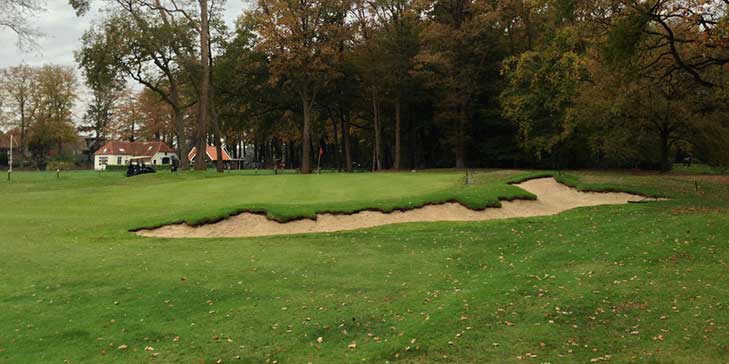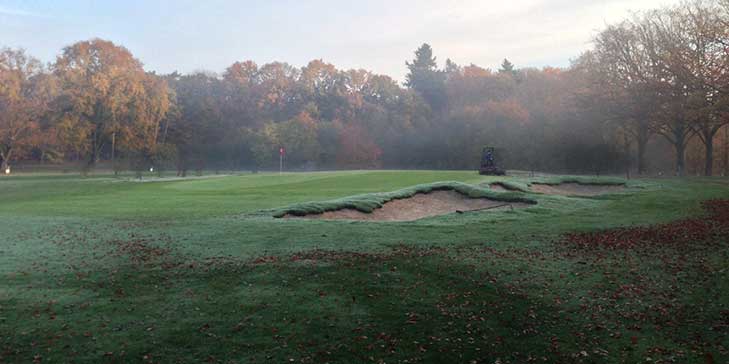Sallandsche bunker renovation on course to be completed before Christmas
Frank Pont of the Infinite Variety Design firm is working alongside Brett Hochstein to help renovate and rejuvenate the bunkering at the Sallandsche Golf Club in Diepenveen, Netherlands.
The Sallandsche course is located close to the city of Deventer in the eastern part of the country, and first opened as a nine-hole course in 1934, designed by Frank Spalding. A further nine holes were added in 1989 by Donald Steel, based on a design drawn up by architect Frank Pennink.
The latest project began in September this year, and GCA spoke with Brett Hochstein, owner of the Hochstein Design firm, to discuss the latest enhancements at Sallandsche, working in Europe, and collaborating with Frank Pont.
“The biggest goal was to improve the aesthetic of the course through new bunkering,” said Hochstein. “To achieve that, I’ve been brought in to shape them. To ensure nothing gets lost but rather only added during the building process, I’ve also done all the finishing work on each of the bunkers and more recently the edging of the grassed-in ones. The generally loose sandy soil is a big part in allowing this to happen without breaking my back or it taking an eternity, and it is a nice opportunity to get every little detail correct.”
In many cases the bunkers at Sallandsche have been moved or replaced as part of the recent work, with the aim of creating more strategic interest.
“Frank has put together a good short-term and long-term plan for making the course more enjoyable,” Hochstein said. “We are currently working within the short-term plan, which includes the building of 39 bunkers and the filling in of 25 others.”
Previously, a number of holes had flanking green side hazards, many of which were set away from the green surface and sometimes invisible to players.
“New strategy has been incorporated on a number of holes – for example on the fourth and seventh holes – by removing a bunker on one side,” explained Hochstein. “The greenside bunkers have been moved closer to the green, thus cutting off the angle from half the approach. In both of these instances, another bunker has been introduced at the approach distance to defend the open side of the green.
“Other greens, like those on holes five and six, have seen more of a total transformation, with reshaping of the green surrounds. On the fifth hole, a strange sort of backstop ringing the green was eliminated, now leaving an intimidating domed horizon in the narrow back half of the green that won’t much faze the common player but might mess with the head of the strong player

A newly-edged bunker on the sixth hole, where back mounding was removed to fill the sideflanking bunkers and create interesting contouring
“At the eleventh hole – a short par-five – the bunker fill-in on the left of the green lying just beyond a set of approach bunkers utilises depth and contours to steer long shots on or off the surface, as well as leaving an interesting up and down from the hollow itself. On the thirteenth hole, a similar thing is happening on the right side where a deep bunker once was. Despite the reduction from two bunkers to one there, the green is still effectively defended on both sides due to the new contouring falling down off the green. The aim at all the greens is more short grass, and we have kept that in mind for every bunker fill-in, being sure to keep it a little interesting if one is to choose a putter over a wedge.”

The reworked thirteenth hole at Sallandsche, with a new left bunker and reshaping and filled in of a bunker on the right side
Pont originally had a vision of a cross between Harry Colt and Tom Simpson-style bunkering for Sallandsche, according to Hochstein.
“The general idea for the bunkers was to create more visibility, texture, and interest while not getting so ornate that the maintenance becomes overly difficult,” Hochstein said. “Doing big capes and bays was out of question, and building the bunkers way up in the sky would not have worked either visually on the low-profile site. I think we would both say things ended up with more of a Simpson-type flair, but with various styles being present in the golf course as a result of the phased build out to 18 holes, I really just wanted to focus on what would look both best to scale and natural in edge and texture without worrying about copying or mimicking a previous set style.”
Work began on 15 September, and the bunker project was given a time span of between 65-70 days with a view to completing the project before Christmas. Pont and Hochstein have worked with both the club and course management contractor De Enk Groene and Golf on the project, which is set to be completed on time.

The greenside of the fourth hole at Sallandsche after edging
Hochstein has enjoyed working in the Netherlands, something he described as a ‘refreshing experience’.
“Things go on schedule, get repaired right away, and get done quickly,” he said. “Since I have been doing my own finish work on this project after completing the shaping, my biggest complaint is that grass sometimes goes down too fast! But that is a very good problem to have.”
This is the first project that Hochstein has collaborated with Frank Pont, and he hopes it will not be the last.
“Frank Pont has been excellent to work with. He is always reasonable, always understanding, and always wanting what is best for the end product,” Hochstein concluded. “He has put together a nice overall strategic plan for the course, but within that he has allowed a lot of input to how things both look and play. I think I have probably done some things he may not have thought of or done before, and conversely he has kept me in check on some things I might have been missing or getting a little carried away with. It has been a lot of fun, and I think the combination of both of us has lead to the best overall product.”